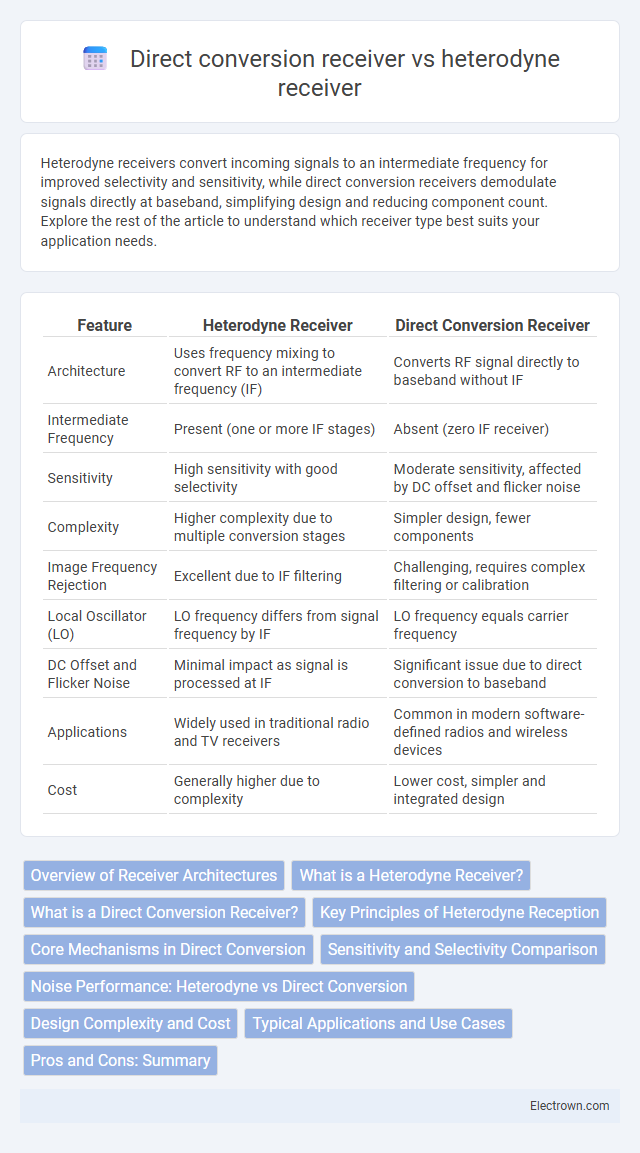Heterodyne receivers convert incoming signals to an intermediate frequency for improved selectivity and sensitivity, while direct conversion receivers demodulate signals directly at baseband, simplifying design and reducing component count. Explore the rest of the article to understand which receiver type best suits your application needs.
Table of Comparison
| Feature | Heterodyne Receiver | Direct Conversion Receiver |
|---|---|---|
| Architecture | Uses frequency mixing to convert RF to an intermediate frequency (IF) | Converts RF signal directly to baseband without IF |
| Intermediate Frequency | Present (one or more IF stages) | Absent (zero IF receiver) |
| Sensitivity | High sensitivity with good selectivity | Moderate sensitivity, affected by DC offset and flicker noise |
| Complexity | Higher complexity due to multiple conversion stages | Simpler design, fewer components |
| Image Frequency Rejection | Excellent due to IF filtering | Challenging, requires complex filtering or calibration |
| Local Oscillator (LO) | LO frequency differs from signal frequency by IF | LO frequency equals carrier frequency |
| DC Offset and Flicker Noise | Minimal impact as signal is processed at IF | Significant issue due to direct conversion to baseband |
| Applications | Widely used in traditional radio and TV receivers | Common in modern software-defined radios and wireless devices |
| Cost | Generally higher due to complexity | Lower cost, simpler and integrated design |
Overview of Receiver Architectures
Heterodyne receivers use frequency mixing to convert incoming signals to an intermediate frequency (IF), providing improved selectivity and sensitivity through well-established filtering techniques. Direct conversion receivers, also known as zero-IF receivers, convert signals directly to baseband, simplifying the architecture while reducing the number of frequency translations and associated components. Your choice between these architectures impacts system complexity, performance in handling strong signals, and suitability for software-defined radio applications.
What is a Heterodyne Receiver?
A Heterodyne Receiver converts a received signal to an intermediate frequency (IF) by mixing it with a locally generated oscillator signal, enabling easier amplification and filtering. This approach offers high sensitivity and selectivity, making it ideal for applications requiring precise frequency tuning and minimal noise. Your choice of receiver influences the complexity and performance of communication systems, with heterodyne designs often preferred for their stability and efficiency in handling weak signals.
What is a Direct Conversion Receiver?
A Direct Conversion Receiver (DCR), also known as a zero-IF or homodyne receiver, directly converts the received radio frequency (RF) signal to baseband without intermediate frequency (IF) stages. This receiver architecture eliminates the need for image frequency filtering and reduces component complexity by mixing the RF signal with a local oscillator at the carrier frequency. DCRs enable simpler and more integrated designs, making them popular for modern wireless communication systems where size, cost, and power efficiency are critical.
Key Principles of Heterodyne Reception
Heterodyne receivers utilize frequency mixing by combining the incoming radio frequency (RF) signal with a locally generated oscillator signal to produce an intermediate frequency (IF) that is easier to process and filter. This key principle enables improved selectivity and sensitivity, reducing noise and interference. The conversion to IF allows for consistent gain and linearity across a wide range of frequencies, making heterodyne reception highly effective for complex communication systems.
Core Mechanisms in Direct Conversion
Direct conversion receivers utilize a single mixing stage that directly converts the received RF signal to baseband without an intermediate frequency, significantly simplifying the architecture. The core mechanism involves mixing the incoming RF signal with a local oscillator signal at the same frequency to produce in-phase (I) and quadrature (Q) baseband components for demodulation. This approach eliminates the need for intermediate frequency filtering and reduces component count, enhancing integration and power efficiency in modern communication systems.
Sensitivity and Selectivity Comparison
Heterodyne receivers typically offer higher sensitivity due to their ability to amplify and filter signals at an intermediate frequency, which reduces noise and improves signal-to-noise ratio. In terms of selectivity, heterodyne receivers excel by using narrowband intermediate frequency filters that effectively isolate the desired signal from adjacent channels. Direct conversion receivers have lower sensitivity and selectivity since they convert the signal directly to baseband, making it more challenging to filter out noise and adjacent channel interference.
Noise Performance: Heterodyne vs Direct Conversion
Heterodyne receivers typically exhibit better noise performance due to their ability to filter and amplify signals at intermediate frequencies, reducing the impact of low-frequency noise and improving selectivity. Direct conversion receivers can suffer from higher low-frequency noise, DC offsets, and I/Q imbalance, which degrade overall signal quality. Understanding these noise characteristics helps you choose the appropriate receiver architecture for sensitive and high-fidelity communication systems.
Design Complexity and Cost
Heterodyne receivers feature multiple frequency conversion stages that increase design complexity and component count, resulting in higher manufacturing costs. Direct conversion receivers simplify the architecture by directly converting the RF signal to baseband, significantly reducing circuit complexity and lowering production expenses. Your choice between these designs depends on balancing performance needs with budget constraints.
Typical Applications and Use Cases
Heterodyne receivers are widely used in radar systems, satellite communications, and high-frequency radio applications due to their superior selectivity and capability to handle weak signals in noisy environments. Direct conversion receivers are favored in modern wireless devices like smartphones, Bluetooth headsets, and software-defined radios because of their simpler architecture, lower power consumption, and ease of integration with digital processing. Each receiver type addresses specific challenges in signal processing, making heterodyne ideal for high-performance signal detection and direct conversion suitable for compact, low-cost consumer electronics.
Pros and Cons: Summary
Heterodyne receivers offer superior selectivity and sensitivity by shifting the received signal to an intermediate frequency for easier filtering, but they involve more complex circuitry and higher power consumption. Direct conversion receivers simplify design and reduce power usage by directly converting RF signals to baseband, yet they often face challenges with DC offset and image frequency interference. The choice depends on application requirements, balancing performance against complexity and cost.
Heterodyne receiver vs direct conversion receiver Infographic

 electrown.com
electrown.com